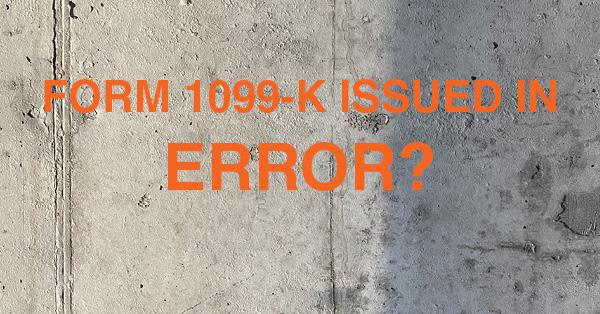FORM 1099-K ISSUED IN ERROR?

Your client thinks a Form 1099-K has been issued in error – what is the next step?
The IRS recommends that the taxpayer contact the filer whose name and contact information appears in the upper-left corner on the front of the form, or the payment settlement entity shown in the lower-left side of the form. Visit IRS.gov for additional answers to frequently asked questions about the Form 1099-K. As a reminder, the IRS announced a delay in reporting thresholds for third-party settlement organizations. As a result, third-party settlement organizations will not be required to report tax year 2022 transactions on a Form 1099-K to the IRS or the payee for the lower, $600 threshold amount enacted as part of the American Rescue Plan of 2021. The existing threshold of over 200 transactions and over $20,000 in total sales will apply for 2022 transactions.
- Is the gain or loss on the sale of a personal item used to compute my taxable income? Is that reported on a Form 1099-K? (added December 28, 2022)
- Gain or loss on the sale of a personal item is generally the difference between the amount you paid for the item (the purchase price) and the amount you receive when you sell it (the sales price).
For example, if you bought a refrigerator for $1,000 (the purchase price) and sold it for $600 (the sales price), you have a loss of $400. $600 sales price - $1,000 purchase price = ($400) loss amount.
On the other hand, if you bought concert tickets for $500 (the purchase price) and sold them for $900 (the sales price), you have a gain of $400. $900 sales price - $500 purchase price = $400 gain amount.
The gain on the sale of a personal item is taxable. You must report the transaction (gain on sale) on Form 8949, Sales and Other Dispositions of Capital Assets, and Form 1040, U.S. Individual Income Tax Return, Schedule D, Capital Gains and Losses. See Publication 551, Basis of Assets, for guidance in determining your basis.
The gain on the sale of a personal item might be reported on a Form 1099-K. If you receive a Form 1099-K reporting the $900 that you received from the sale of your concert tickets that cost you only $500, you must report the gain on Form 8949 and Schedule D.
The loss on the sale of a personal item is not deductible. For calendar year 2022 tax returns, if you receive a Form 1099-K, for the sale of a personal item that resulted in a loss, you should make offsetting entries on Form 1040, U.S. Individual Income Tax Return, Schedule 1, Additional Income and Adjustments to Income, as follows:
Report your proceeds (the Form 1099-K amount) on Part I – Line 8z – Other Income, using the description "Form 1099-K Personal Item Sold at a Loss."
Report your costs, up to but not more than the proceeds amount (the Form 1099-K amount), on Part II – Line 24z – Other Adjustments, using the description "Form 1099-K Personal Item Sold at a Loss."
In the example of the refrigerator sale above, if you received a Form 1099-K for $600 for the refrigerator for which you originally paid $1,000, you should report the loss transaction as follows:
Form 1040, Schedule 1, Part I – Line 8z,Other Income. List type and amount: "Form 1099-K Personal Item Sold at a Loss …. $600" to show the proceeds from the sale reported on the Form 1099-K
and,
Form 1040, Schedule 1, Part II – Line 24z,Other Adjustments. List type and amount: "Form 1099-K Personal Item Sold at a Loss…. $600" to show the amount of the purchase price that offsets the reported proceeds. Do not report the $1,000 you paid for the refrigerator because the loss on the sale of a personal item is not deductible.




